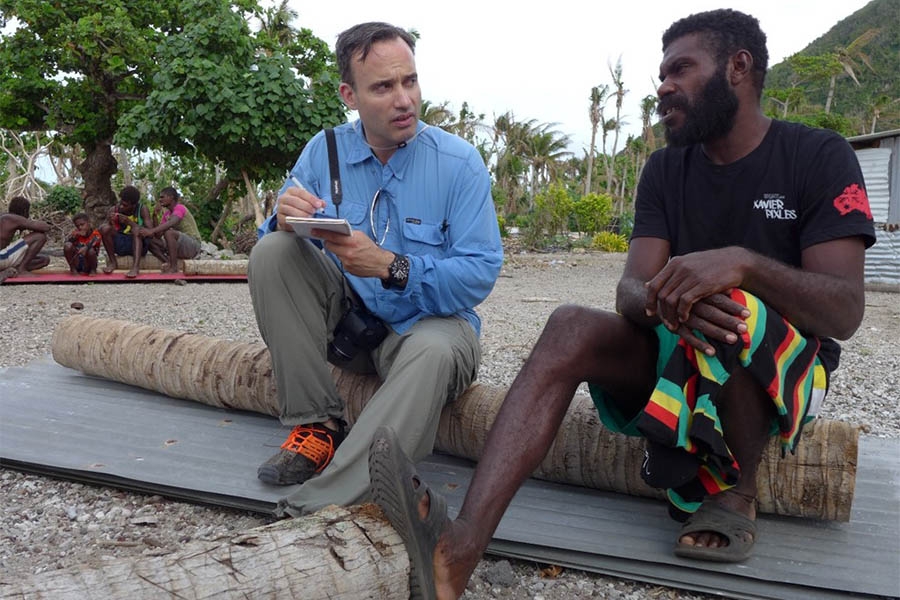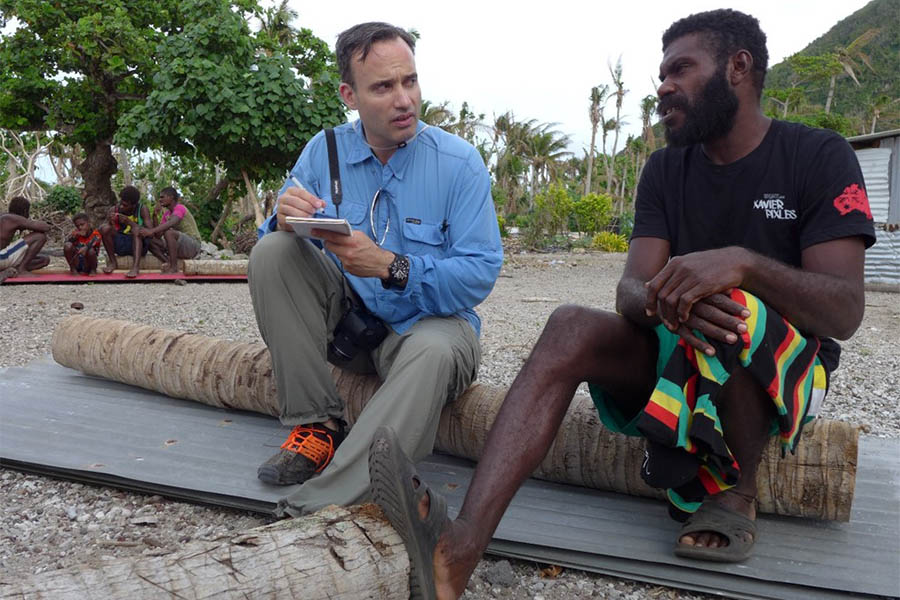
|
|
| Professor Hermann Fritz, left, conducting an interview on the Pacific island of Vanatu. |
Hermann Fritz heard the news on the radio. It was the day after Christmas in 2004, and Fritz, a civil engineer who lived in Georgia, was visiting his parents' home in Zurich, Switzerland, for the holidays. The reporter's voice crackled through the speaker: There had been an earthquake in the Indian Ocean. A tsunami had followed. Thousands of people were presumed dead.
Fritz, then 32, was shocked by the human toll. But he also listened with professional interest. He'd recently been hired as a professor at the Georgia Institute of Technology in Savannah, where he studied tsunamis. Unlike beach waves guided by wind, tsunamis gain their momentum from earthquakes, volcanoes, or landslides that can occur deep in oceans or lakes or along the shores and displace massive amounts of water. The jolt triggers a series of waves that swell over minutes, or in some cases hours, reaching heights taller than most buildings. Fritz knew all this, but there hadn't been a tsunami like this in his lifetime.
To his dismay, the news provided few details, so Fritz logged on to the boxy family computer and plugged in the URL for the United States Geological Survey's National Earthquake Information Center to see what he could find out.
A displacement had occurred between the India and Burma plates, 45 miles off the west coast of northern Sumatra. The earthquake's initial magnitude was estimated at 8.0 on the Richter scale, and scientists at the Pacific Tsunami Warning Center had expected, at most, some regional tsunami damage on nearby islands. But they were wrong. Almost 40 hours after the quake, they learned that its true force stayed hidden as it traveled along 745 miles of fault line. Seismologists upgraded the magnitude to 9.0, but the final reading, published in May 2005, indicated that the Indian Ocean quake had one of the highest magnitudes ever recorded: 9.1.
The waves barreled across the Indian Ocean and drowned vacationers on Thai beaches, ripped apart thousands of homes and killed whole families in Indonesia, and washed up on shores as far away as South Africa. When the water receded and the toll was assessed, 230,000 people were dead and 1.7 million others had lost their homes. As one scientist who was working in the Pacific Tsunami Warning Center that day told me, it was “perhaps the most destructive tsunami since the dawn of civilization.”
It's been 15 years since the Indian Ocean tsunami. Back then, a relatively small number of scientists studied the freak wave events, and they had only a handful of videos, including grainy black-and-white footage from the 1946 Hawaiian tsunami, to work from. But since the disaster, the field has advanced rapidly. The immense tragedy created a sense of urgency among disaster planners and government funders. But the scientific advances were also made possible by an unrelated technological development: easy-to-use video recording devices in the hands of ordinary people. Because of images that onlookers filmed of the eerie approaching waves, scientists are now able to create detailed maps of where tsunamis will hit and how the water is likely to surge inland.
As he sat at his parents' desk that December morning, monitoring the US Geological Survey site and an international Tsunami Bulletin Board, Fritz realized he'd be needed. His particular expertise was even more esoteric than that of most tsunami experts: More than 80 percent of tsunamis are caused by earthquakes, but Fritz had been drawn to those of uncommon origin—volcanoes, landslides, underwater eruptions. Early on, he'd studied the phenomenon in Alpine lakes, where thawing permafrost could create landslides. But with so few experts in the field, there was no staying behind. A week after New Year's, he was on a plane to Sri Lanka.
Continue reading at wired.com.This story appears in the October issue of WIRED.
Related Links
- NSF natural hazard group highlights Fritz's unique volcanic landslide generator
- Fritz, colleagues find surprising clue to severity of Indonesia tsunami
- WIRED

